Spatial Distribution Characteristics and Influencing Factors of Key Rural Tourism Villages in China
Abstract
1. Introduction
2. Materials and Methods
2.1. Data Sources
2.2. Methods
2.2.1. Nearest Neighbor Index
2.2.2. Geographic Concentration Index
2.2.3. Disequilibrium Index
2.2.4. Kernel Density Estimation
2.2.5. Geographic Connection Rate
2.2.6. Spatial Autocorrelation Analysis
3. Results
3.1. Spatial Distribution Characteristics
3.1.1. Spatial Distribution Equilibrium
3.1.2. Spatial Distribution Pattern
3.1.3. Spatial Distribution Density
3.1.4. Spatial Distribution Correlation
3.2. Analysis of Influencing Factors
3.2.1. Natural Environmental Factors
Elevation above Sea Level
River System
3.2.2. Resource Endowment Factor
3.2.3. Socioeconomic Factors
Population Density
Economic Development Level
Traffic Location Conditions
3.2.4. Tourist Market Factors
3.2.5. Policy Factors
4. Discussion
5. Conclusions
- The spatial distribution of key rural tourism villages in China has an obvious regional differentiation and generally presents the spatial structure characteristics of “dense in the east and sparse in the west”, which may be related to the population density and the level of economic development in different regions. Meanwhile, the spatial distribution of key villages presents a cohesive distribution trend.
- In terms of spatial density distribution, the very high-density agglomeration centers were mainly located in the Beijing–Tianjin–Hebei region represented by Beijing and Tianjin and the Yangtze River Delta region at the junction of Jiangsu, Zhejiang, Anhui, and Shanghai, while the low-density areas mainly include the southern Tibet area with Lhasa as the center, the Junggar Basin at the northern foot of Tianshan Mountains in Xinjiang, and the Changbai Mountain area in the eastern part of the Liaoning and Jilin provinces. It can be seen from this that the kernel density distribution of key tourism villages in China is independent and obvious, with high density concentrated in the southeast and low density concentrated in the northwest. Its distribution shows a clear imbalance. Therefore, in the process of developing and constructing key tourism villages in the future, priority should be given to areas with low kernel density, rich tourism resources, and a high level of economic development.
- Tourism villages showed a significant spatial autocorrelation, and the key rural tourism villages in different regions represented spatial agglomeration characteristics. The hot spots were mainly concentrated in Beijing, Tianjin, Jiangsu, Shanghai, and Zhejiang, while the cold spots were mainly concentrated in the Qinghai–Tibet Plateau and Sichuan Basin. The distribution of cold and hot spots in the distribution of key tourism villages in China is independent and obvious, and its distribution shows a clear imbalance. In the process of selecting key tourism villages in the future, priority should be given to cold hot spot areas.
- The spatial distribution characteristics of key rural tourism villages were the result of the interaction and coupling of multiple factors. The analysis of topographic factors shows that the key villages of rural tourism are more distributed in the plain and hilly areas with relatively gentle and low altitude, which can provide different experiences for tourists, provide site selection for the development and construction of key tourism villages in the future, and promote the sustainable development of rural tourism. Consistent with the existing conclusions, the distribution of rural tourism key villages near the source of the river is denser, and with the increase in distance from the water area, the distribution of villages is more discrete, showing hydrophilicity. In densely populated areas, agricultural production activities are concentrated, which promotes the formation and development of rural tourism. In addition, there is a strong correlation between the level of economic development and the distribution of key villages. Residents in areas with higher level of economic development have higher requirements for rural tourism leisure and are more willing to pay for rural tourism services, thus promoting the sustainable development of rural tourism. The analysis of traffic location factors shows that the traffic accessibility of rural tourism destinations directly affects the accessibility of tourists. Most of the key tourist villages are located within the radiation range of 40 km of the highway, and citizens are more inclined to travel for short distances. The distance between the development of rural tourism destinations and urban centers has a positive impact on the development of tourism. The key villages of rural tourism are surrounded by the buffer zones established by provincial capitals and prefecture-level cities, which is consistent with the conclusions of previous studies. To sum up, these factors are important factors to promote the sustainable development of rural tourism.
- The research results of this paper have important theoretical significance and practical value for the full implementation of the rural revitalization strategy in the new era, the promotion of tourism supply side structural reform, and the improvement of rural tourism scale efficiency and sustainable development. Based on the analysis of this paper, the development of key rural tourism villages is unbalanced in space, and the eastern region is obviously better than the central and western regions. Therefore, it provides scientific guiding significance for optimizing the spatial structure layout of rural tourism key villages, rationally allocating tourism spatial resources and promoting the sustainable development of rural tourism. The high-density areas and hot spots of key rural tourism villages are mostly concentrated in the Yangtze River Delta and Beijing–Tianjin–Hebei region, and the proportion of areas east of Hu Huanyong Line is as high as 80.82%. In the future, it can provide reference for realizing the balance and heterogeneity of key rural tourism villages, aiming at promoting the sustainable development of rural tourism with high quality. In addition, from the perspective of traffic location, the 20 km buffer zone of the main highway traffic line covers 746 key rural tourism villages, accounting for 62.2%, which shows that the accessibility of rural tourism needs to be improved. Therefore, this is needed in order to strengthen the construction of rural tourism transportation network and build a sustainable development system for the accessibility of rural tourism destinations.
- There are some limitations or weaknesses in this study. First, the Chinese Culture and Tourism Bureau has published three lists of key rural tourism villages in China. The authors made a static analysis of the spatial dimension of key tourism villages, but not a dynamic analysis from the time series level. Therefore, follow-up studies can gradually expand the research perspective to the time dimension according to the publication of the directory. Second, in this study, we conducted a single preliminary exploration of the main factors affecting the formation of key villages for rural tourism. However, access to rural data is constrained, and we did not conduct a quantitative study on the coupling coordination among key tourism villages in different regions and the local environment, economy, population, transportation, and urbanization. These aspects need further study. To improve the pertinence and effectiveness, we will select different types of key rural tourism villages with representativeness to conduct field research and case studies and carry out special discussions and studies on the promotion of local rural tourism sustainable development and employment of local farmers in future research.
Author Contributions
Funding
Institutional Review Board Statement
Informed Consent Statement
Data Availability Statement
Conflicts of Interest
References
- Crompton, J.L. Motivations for Pleasure Vacation. Ann. Tour. Res. 1979, 6, 408–424. [Google Scholar] [CrossRef]
- Wang, X.W.; Li, X.J. Spatial characteristics and influencing factors of key villages in rural tourism in China. Acta. Geogr. Sin. 2022, 77, 900–917. [Google Scholar]
- Zhang, H.; Duan, Y.; Han, Z.L. Research on spatial patterns and sustainable development of rural tourism destinations in the Yellow River Basin of China. Land 2021, 10, 849. [Google Scholar] [CrossRef]
- Liu, Y.S. Urban-rural integration and rural revitalization in the new era of China. Acta Geogr. Sin. 2018, 73, 637–650. [Google Scholar]
- Li, X.X.; Ma, X.L.; Wu, B.H. Spatial structure of Chinese excellent tourism cities and its mechanism. J. Arid. Land Resour. Environ. 2006, 20, 120–124. [Google Scholar]
- Wang, T.; Tai, P.F. Spatial differentiation characteristics and influencing factors of national rural tourism destinations in Shandong province. Econ. Geogr. 2016, 36, 161–168. [Google Scholar]
- Koscak, M. Integral development of rural areas, tourism and village renovation, Trebnje, Slovenia. Tour. Manag. 1998, 19, 81–86. [Google Scholar] [CrossRef]
- Tchetchik, A.; Fleischer, A.; Finkelshtain, I. Differentiation and synergies in rural tourism: Estimation and simulation of the Israeli Market. Am. J. Agric. Econ. 2008, 90, 553–570. [Google Scholar] [CrossRef]
- Kong, Q.S.; Li, H.Y.; Shi, W.L. Evaluation of leisure agriculture in Hebei Province based on DEA: A case study of leisure agriculture and rural tourism demonstration sites in Hebei province. Chin. J. Ecol. Agric. 2013, 21, 511–518. [Google Scholar] [CrossRef]
- Li, T.; Tao, Z.M.; Li, Z.J. Research on the types and spatial-temporal characteristics of rural tourist attractions in Jiangsu province based on GIS technology. Econ. Geogr. 2014, 34, 179–184. [Google Scholar]
- Zhou, L.; Jiang, J.L. Comprehensive evaluation and spatial differentiation of urban tourism competitiveness in the Yangtze River Delta. Econ. Geogr. 2015, 35, 173–179. [Google Scholar]
- Park, D.-B.; Yoon, Y.S. Segmentation by motivation in rural tourism: A Korean case study. Tour. Manag. 2009, 30, 99–108. [Google Scholar] [CrossRef]
- Baležentis, T.; Kriščiukaitienė, I.; Baležentis, A.; Garland, R. Rural tourism development in Lithuania (2003–2010): A quantitative analysis. Tour. Manag. Perspect. 2012, 2–3, 1–6. [Google Scholar] [CrossRef]
- Zhang, X.M. Research on the development strategies of rural tourism in Suzhou based on SWOT analysis. Energy Procedia 2012, 16, 1295–1299. [Google Scholar] [CrossRef]
- Cucari, N.; Wankowicz, E.; De Falco, S.E. Rural tourism and Albergo Diffuso: A case study for sustainable land-use planning. Land Use Policy 2019, 82, 105–119. [Google Scholar] [CrossRef]
- Atun, R.A.; Nafa, H.; Turker, O. Envisaging sustainable rural development through “context-dependent tourism”: Case of northern Cyprus. Environ. Dev. Sustain. 2019, 21, 1715–1744. [Google Scholar] [CrossRef]
- Fatimah, T. The Impacts of Rural Tourism Initiatives on Cultural Landscape Sustainability in Borobudur Area. Procedia Environ. Sci. 2015, 28, 567–577. [Google Scholar] [CrossRef][Green Version]
- Butler, R.; Clark, G.; Bowler, I.R.; Bryant, C.R.; Nellis, M.D. Tourism in rural areas: Canada and the United Kingdom. Econ. Soc. 1992, 16, 166–183. [Google Scholar]
- Christaller, W. Some considerations of tourism location in Europe: The peripheral regions-under-developed countries-recreation areas. Pap. Reg. Sci. 1964, 12, 95–105. [Google Scholar] [CrossRef]
- Saxena, G.; Ilbery, B. Developing integrated rural tourism: Actor practices in the English/Welsh border. J. Rural Stud. 2010, 26, 260–271. [Google Scholar] [CrossRef]
- Cikic, J.; Petrovic, M.; Djurdjev, B. Diffusion of knowledge and rural tourism development: Example of Vojvodina. Ekon. Poljopr. 2015, 62, 123–136. [Google Scholar] [CrossRef]
- Mottiar, Z.; Boluk, K.; Kline, C. The roles of social entrepreneurs in rural destination development. Ann. Tour. Res. 2018, 68, 77–88. [Google Scholar] [CrossRef]
- Pavlovich, K. The evolution and transformation of a tourism destination network: The Waitomo Caves, New Zealand. Tour. Manag. 2003, 24, 203–216. [Google Scholar] [CrossRef]
- Lee, S.-H.; Choi, J.-Y.; Yoo, S.-H.; Oh, Y.-G. Evaluating spatial centrality for integrated tourism management in rural areas using GIS and network analysis. Tour. Manag. 2013, 34, 14–24. [Google Scholar] [CrossRef]
- Nepal, S.K. Tourism and rural settlements Nepal’s Annapurna region. Ann. Tour. Res. 2017, 34, 855–875. [Google Scholar] [CrossRef]
- Walford, N. Patterns of development in tourist accommodation enterprises on farms in England and Wales. Appl. Geogr. 2001, 21, 331–345. [Google Scholar] [CrossRef]
- Beeton, S. Rural tourism in Australia—has the gaze altered? Tracking rural images through film and tourism promotion. Int. J. Tour. Res. 2004, 6, 125–135. [Google Scholar] [CrossRef]
- Saxena, G.; Clark, G.; Oliver, T. Conceptualizing integrated rural tourism. Tour. Geogr. 2007, 9, 347–370. [Google Scholar] [CrossRef]
- Dávid, L.; Baros, Z.; Patkós, C.; Tuohino, A. Lake tourism and global climate change: An integrative approach based on Finnish and Hungarian case-studies. Carpathian J. Earth Environ. Sci. 2012, 7, 121–136. [Google Scholar]
- Miller, G. The development of indicators for sustainable tourism: Results of a Delphi survey of tourism researchers. Tour. Manag. 2001, 22, 351–362. [Google Scholar] [CrossRef]
- Ivona, A.; Rinella, A.; Rinella, F.; Epifani, F.; Nocco, S. Resilient rural areas and tourism development paths: A comparison of case studies. Sustainability 2021, 13, 3022. [Google Scholar] [CrossRef]
- Briedenhann, J.; Wickens, E. Rural tourism-meeting the challenges of the new South Africa. Int. J. Tour. Res. 2004, 6, 189–203. [Google Scholar] [CrossRef]
- Peng, H.; He, R.X.; Weng, S.X. Multi-subject co-governance model of tourism urbanization in rural areas: A case study of Shuijian village in Tainingcounty, Fujian. Geogr. Res. 2018, 37, 2383–2398. [Google Scholar]
- Yu, R.Z.; Zhang, Y.G.; Yu, X.Y. Research on the configuration and path of influencing factors of rural tourism destination development: Qualitative comparative analysis based on 17 rural tourism destination cases. Econ. Geogr. 2021, 41, 225–231. [Google Scholar]
- Zhang, R.Y.; Fu, X.; Zhang, M.; Du, W.W. A study on the perception of social exclusion of residents in informal employment in rural tourism: A case study of Zhuji ancient lane. Tour. Trib. 2019, 34, 26–36. [Google Scholar]
- Jia, Y.J.; Wang, D.G. Dynamic changes of tourism impact perception and attitude of community residents. Tour. Trib. 2015, 30, 65–73. [Google Scholar]
- Xu, Q. Research on spatial agglomeration of rural tourism based on the point-axis system theory: Taking Jiangshan City, Zhejiang Province as an example. Econ. Geogr. 2013, 33, 174–178. [Google Scholar]
- Liu, H.M.; Yang, S.D.; Xia, K.S.; Yang, S.T. Spatial structure analysis and optimization of rural tourism resources in ethnic poor mountainous areas: A case study of southeast Chongqing. Chin. J. Agric. Res. Reg. Plan. 2018, 39, 276–283. [Google Scholar]
- Wang, X.Y.; Hou, J.J. Spatial distribution characteristics and influencing factors of rural leisure tourism destinations in Shandong Province. Sci. Geogr. Sin. 2016, 36, 1706–1714. [Google Scholar]
- Wang, Y.B.; Song, Y.; Huang, S.; Chen, H.L.; Zhang, L.X. Spatial distribution and influencing factors of rural tourism demonstration villages in Gansu province. Chin. J. Agric. Res. Reg. Plan. 2020, 41, 240–247. [Google Scholar]
- Li, J.; Gao, L. Research on the impact of rural tourism on farmers’ agricultural and forestry production and migrant workers: Based on the survey data of 22 tourism poverty alleviation villages in Shaanxi Province. Hum. Geogr. 2019, 34, 143–151. [Google Scholar]
- Xi, J.C.; Wang, S.K.; Zhang, R.Y. Spatial reconstruction and optimization of “Production-Life-Ecology” in tourism rural settlement: A case study of Gougezhuang village in Yesanpo tourism area, Hebei Province. J. Nat. Resour. 2016, 31, 425–435. [Google Scholar]
- Chen, J.; Yang, X.J.; Wen, X.; Deng, M.Q. Theoretical framework and demonstration of rural adaptive evolution in the context of tourism development. J. Nat. Resour. 2020, 35, 1586–1601. [Google Scholar]
- Tao, H.; Gao, J.; Chen, K.Q. Spatial change of rural tourism: A case study of Mufu Town, Hubei Province. China. J. Resour. Ecol. 2020, 11, 633–644. [Google Scholar]
- He, Q.F.; Ning, Z.Z. Thoughts on tourism precision poverty alleviation promoting rural revitalization in Poverty-stricken areas. Res. Agric. Mod. 2019, 40, 721–727. [Google Scholar]
- Hu, M.J.; Li, Z.J.; Hou, G.L.; Li, T. Spatial pattern and multi-scale characteristics of rural tourist attractions in Jiangsu Province. Econ. Geogr. 2015, 35, 202–208. [Google Scholar]
- Li, Z.L. Research on the coupling mechanism and coordinated development of rural revitalization-rural tourism system: A case study of Fenghuang County, Hunan Province. Geogr. Res. 2019, 38, 643–654. [Google Scholar]
- Yang, Q.; Zhang, F.T.; An, Y.Z.; Wu, J.F.; Sun, C.C.; Zhang, Y.; Wei, Z.; Dai, S.J. Spatial distribution characteristics and influencing factors of tourism poverty alleviation villages in Guizhou province: A case study of national key rural tourism poverty alleviation villages. Res. Soil Water Conserv. 2021, 28, 316–322+329. [Google Scholar]
- Xu, X.; Zhang, W.Z. China’s four regional plates: Growth differences, comparative advantages and the development path of the 14th Five-year plan. Econ. Geogr. 2021, 41, 1–9. [Google Scholar]
- Tang, C.L.; Guo, X.S.; Zhou, G.H.; Wu, J.M.; Chen, W.Y. Spatial distribution and influencing factors of innovation platform in urban agglomeration in the middle reaches of the Yangtze River. Prog. Geogr. 2020, 39, 531–541. [Google Scholar] [CrossRef]
- Xie, Z.H.; Wu, B.H. Study on tourism spatial structure of resource-based scenic spots in China. Sci. Geogr. Sin. 2008, 28, 748–753. [Google Scholar]
- Lorenz, M.O. Methods of measuring the concentration of wealth. Publ. Am. Stat. Assoc. 1905, 9, 209–219. [Google Scholar] [CrossRef]
- Liu, L.; Jiang, C.; Zhou, S.H.; Liu, K.; Xu, C.; Cao, J.J. Multi-scale spatio-temporal pattern analysis of urban burglary crime: A case study of DP Peninsula in H City, China. Geogr. Res.-Aust. 2017, 36, 2451–2464. [Google Scholar]
- Wu, P.; Li, T.S.; Li, W.M. Spatial differentiation of rural poverty and its influencing factors at county level: A case study of Shanyang County, Shaanxi Province. Geogr. Res.-Aust. 2018, 37, 593–606. [Google Scholar]
- Gong, J.; Wu, Q.; Liu, D.J. Study on spatial differentiation and influence mechanism of excellent tourist cities in China. Hum. Geogr. 2014, 29, 150–155. [Google Scholar]
- Hu, H.Y. Distribution of China’s population. Acta Geogr. Sin. 1935, 2, 33–74. [Google Scholar]
- Sun, J.W. The 14th five-year plan and regional economic development in the new era. China Pol. Rev. 2021, 3, 98–104. [Google Scholar]
- Wang, D.G. Fully understand the significance of “key village of rural tourism” in promoting rural revitalization. China Tour. Daily 2020, 3, 1–2. [Google Scholar]
- Dong, W.J.; Wang, C.S.; Zhang, Z. Research on the spatial-temporal coupling of rural revitalization and rural tourism in Shandong province. Sci. Geogr. Sin. 2020, 40, 628–636. [Google Scholar]
- Hu, X.X. To understand the three dimensions of “building a well-off society in an all-round way”: Historical pattern, new interpretation of connotation, and significance of the times. Theor. Mon. 2020, 10, 22–32. [Google Scholar]
- Zhao, X.Y.; Wang, R.; Wang, X.Q.; Liu, J.H. Spatial-temporal distribution and influencing factors of environmental pollution events in China based on multi-scale. Sci. Geogr. Sin. 2019, 39, 1361–1370. [Google Scholar]
- Zhou, Y.; Huang, H.; Liu, Y.S. The spatial distribution characteristics and fluencing factors of Chinese villages. Acta Geogr. Sin. 2020, 75, 2206–2223. [Google Scholar]
- Zhu, Y.Y.; Zhou, X.Q.; Chen, S.Y.; Tu, Z.F. Study on the spatial distribution and influencing factors of key rural tourism villages in China. J. Cent. Chin. Normal. Uni. 2020, 54, 874–881+912. [Google Scholar]
- Ma, L.J.C.; Zhao, S. Physical Geography of China. Geogr. Rev. 1987, 77, 492–493. [Google Scholar] [CrossRef]
- Min, Q.W.; Liu, M.C.; Yang, L. Types, value and protection of agricultural cultural heritage in the Yellow River Basin. Democr. Sci. 2018, 6, 26–28. [Google Scholar]
- Qi, Y.L.; Wang, L.L.; Li, D.; Liu, X.J.; Xiao, R.R. Spatial distribution and influencing factors of key rural tourism villages in China Resour. Dev. Mark. 2021, 37, 734–740+746. [Google Scholar]
- Ma, B.B.; Chen, X.P.; Ma, K.K.; Pu, L.L. Distribution, type structure and influencing factors of key rural tourism villages in China. Econ. Geogr. 2020, 40, 190–199. [Google Scholar]
- Fang, Y.L.; Huang, Z.F.; Li, J.L.; Wang, F. Spatial distribution and industrial characteristics of small towns with Chinese characteristics. J. Nat. Resour. 2019, 34, 1273–1284. [Google Scholar]
- Zheng, Q.M.; Tian, T.; Yang, X.Y. Spatial distribution characteristics and influencing factors of national forest villages in China. J. Chin. Ecotour. 2021, 11, 441–454. [Google Scholar]
- He, Z.L.; Liu, J.; Wang, S.M. Study on the spatial distribution characteristics and influencing factors of key rural tourism villages in China. J. Guangxi Univ. Nat. 2020, 42, 88–93. [Google Scholar]
- Zhu, L.; Hu, J.; Xu, X.T.; Liu, D.J.; Wang, J. Spatial distribution pattern and causes of poverty alleviation by tourism in China. China Popul. Resour. Environ. 2016, 26, 130–138. [Google Scholar]
- Wu, B.H.; Huang, Z.W.; Ma, X.M. Spatial structure of rural tourism destinations around cities in China. Sci. Geogr. Sin. 2004, 6, 757–763. [Google Scholar]
- Zhang, A.; Yang, Y.; Chen, T.; Liu, J.; Hu, Y. Exploration of spatial differentiation patterns and related influencing factors for National Key Villages for rural tourism in China in the context of a rural revitalization strategy using GIS-based overlay analysis. Arab. J. Geosci. 2021, 14, 83 . [Google Scholar] [CrossRef]
- Shi, Z.; Xu, D.; Xu, L. Spatiotemporal characteristics and impact mechanism of high-quality development of cultural tourism in the Yangtze River Delta urban agglomeration. PLoS ONE 2021, 16, e0252842. [Google Scholar] [CrossRef]
- Zheng, G.H.; Jiang, D.F.; Chen, G.L.; Luan, Y.F. Research on the spatial distribution pattern and influencing mechanism of key villages in rural tourism in China. J. Arid Land Res. Environ. 2020, 34, 194–201. [Google Scholar]
- Weng, G.M.; Shen, K.; Pan, Y. Spatial differentiation characteristics and formation mechanism of rural tourism destinations in China: Based on 1000 key rural tourism villages in China. Geogr. Geo-Inf. Sci. 2021, 37, 99–105+136. [Google Scholar]
- Qi, J.W.; Lu, Y.Y.; Han, F.; Ma, X.K.; Yang, Z.P. Spatial distribution characteristics of the rural tourism villages in the Qinghai-Tibetan Plateau and its influencing factors. Int. J. Environ. Res. Public Health 2022, 19, 9330. [Google Scholar] [CrossRef]
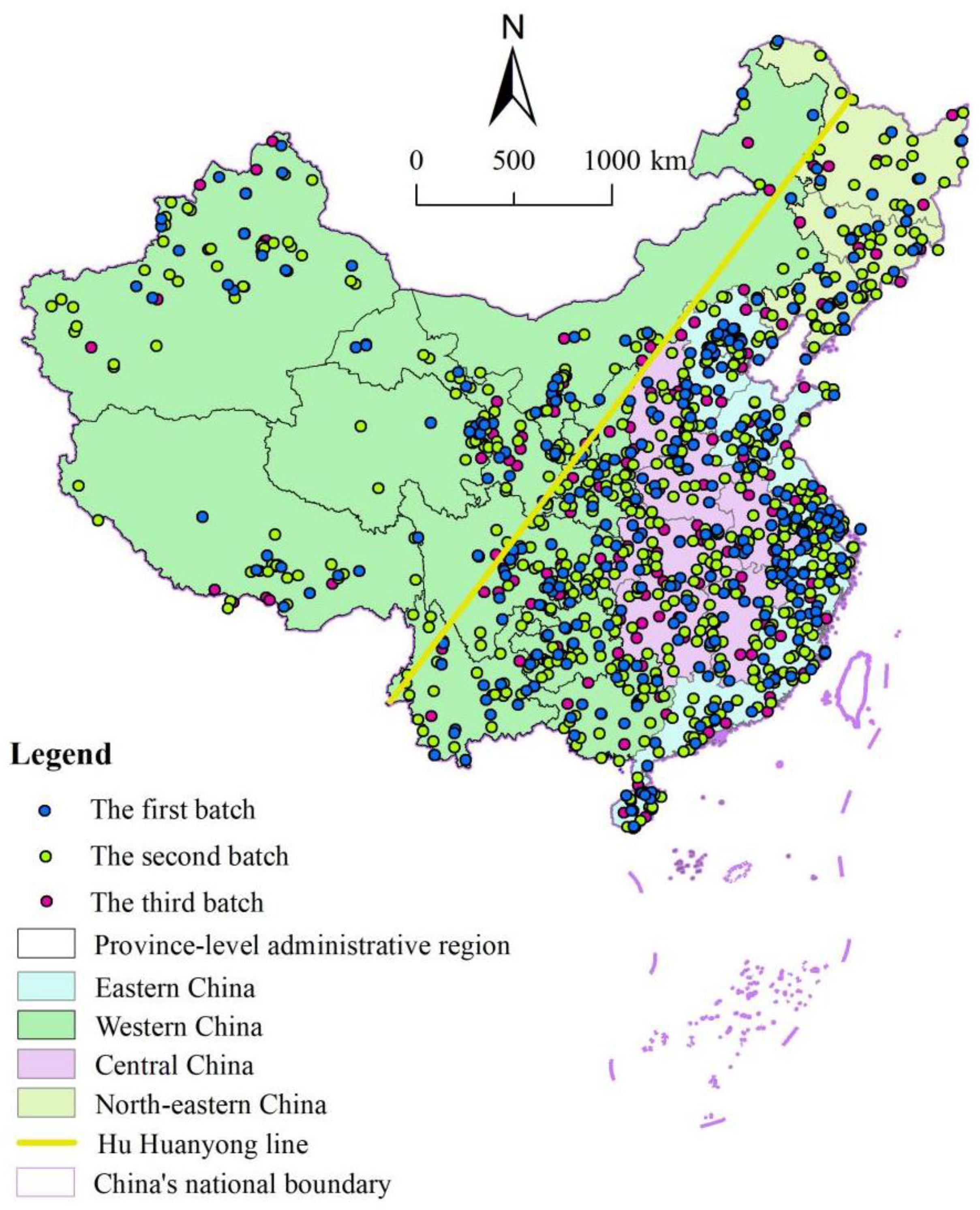
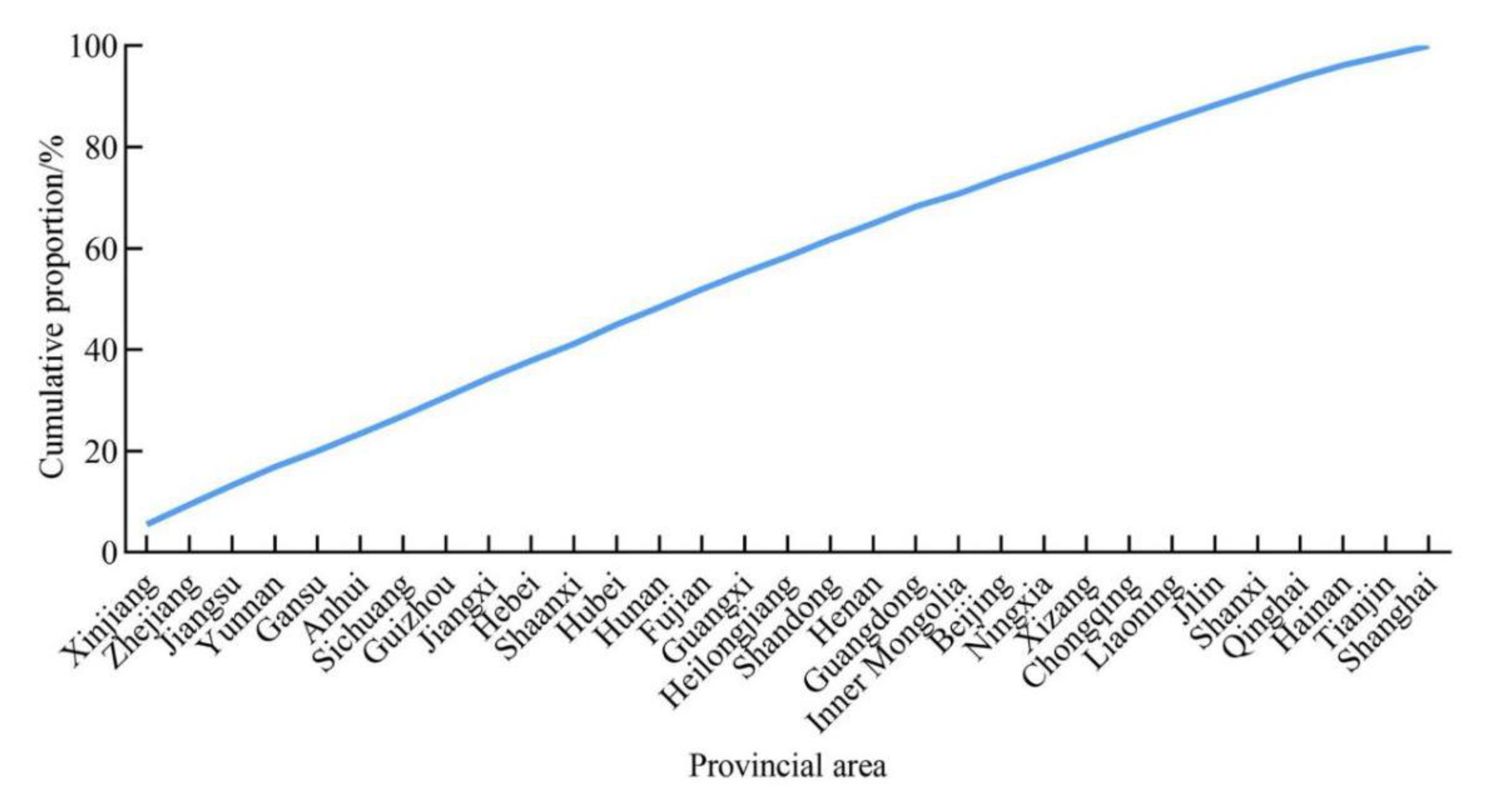



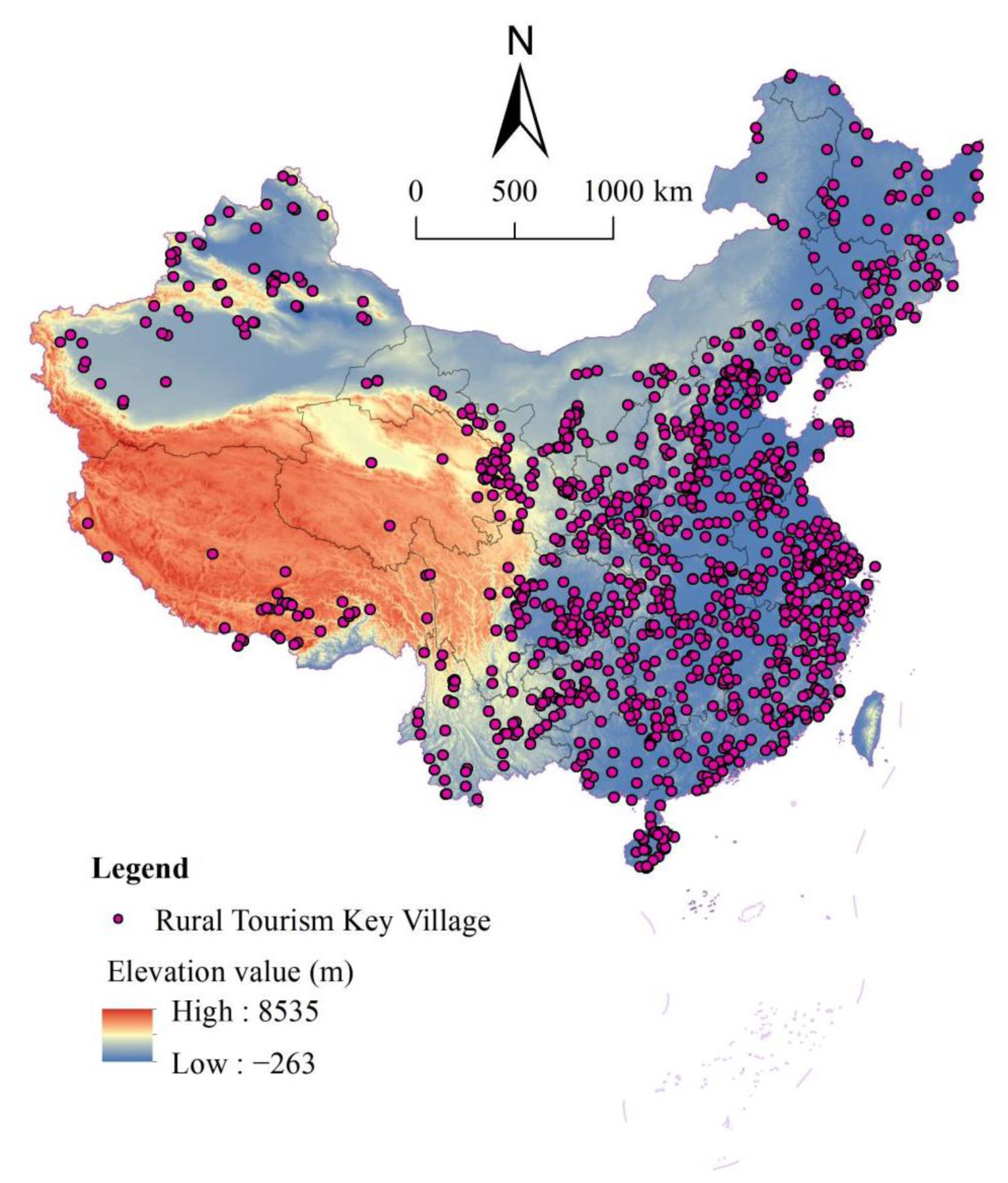
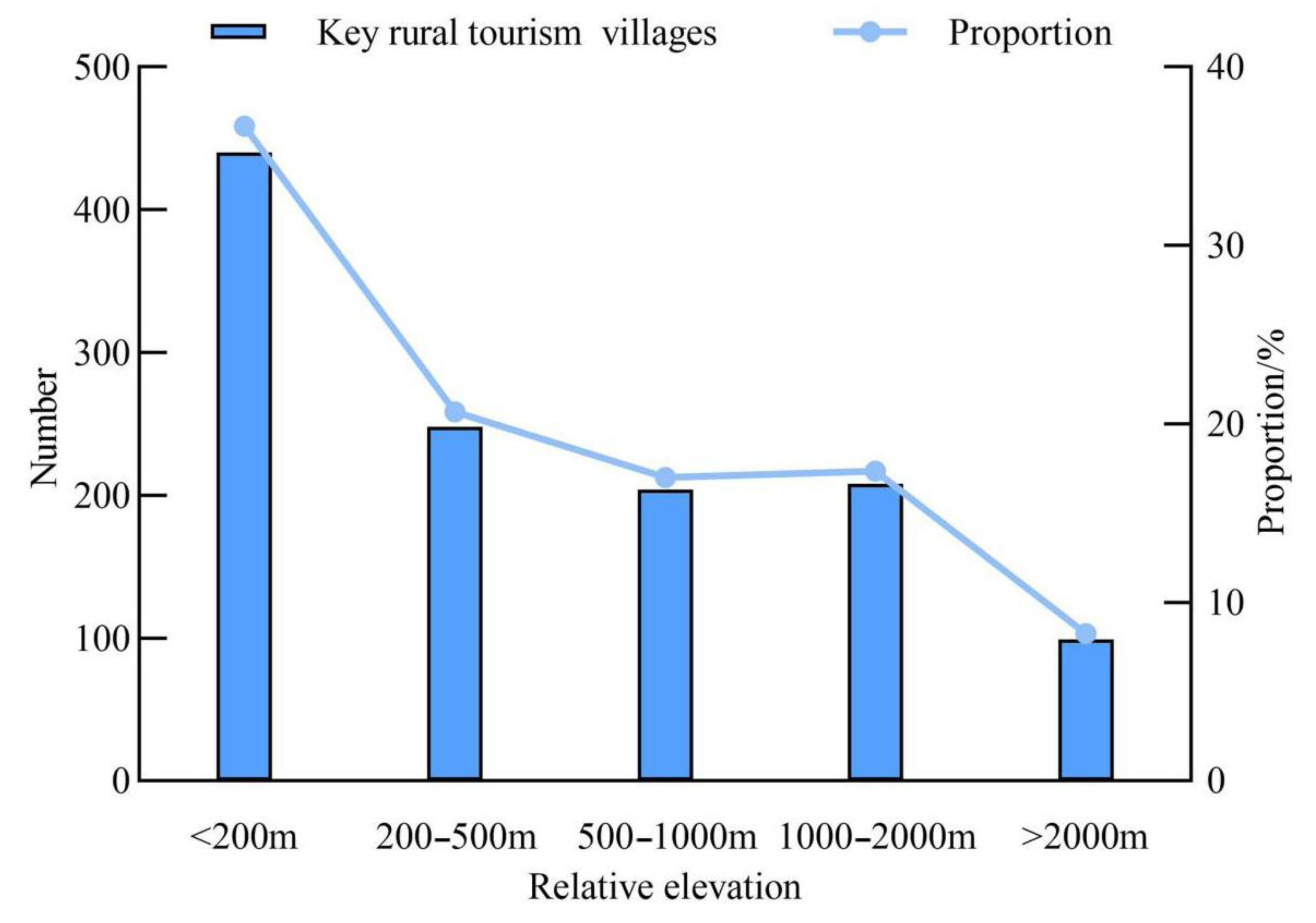
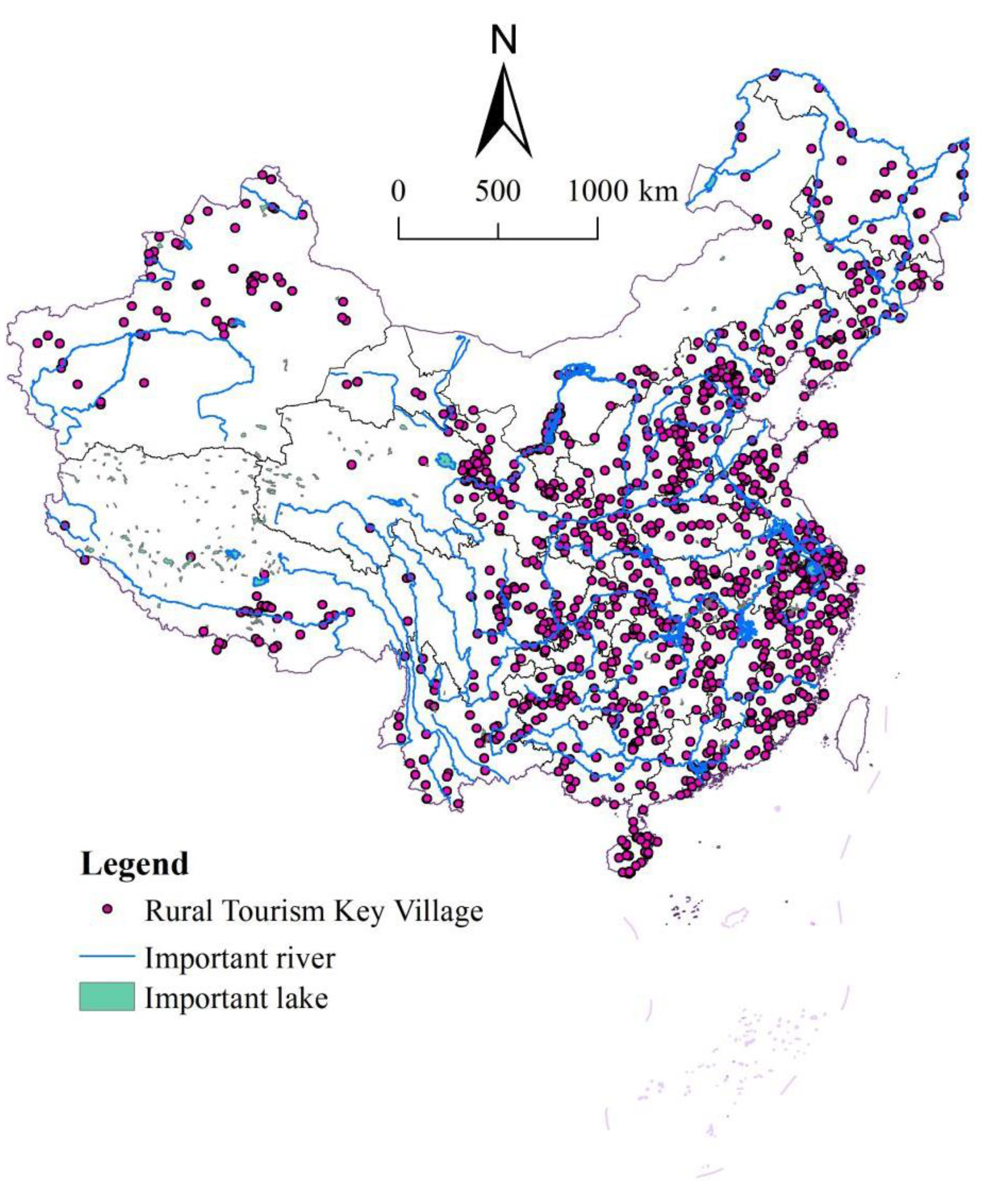
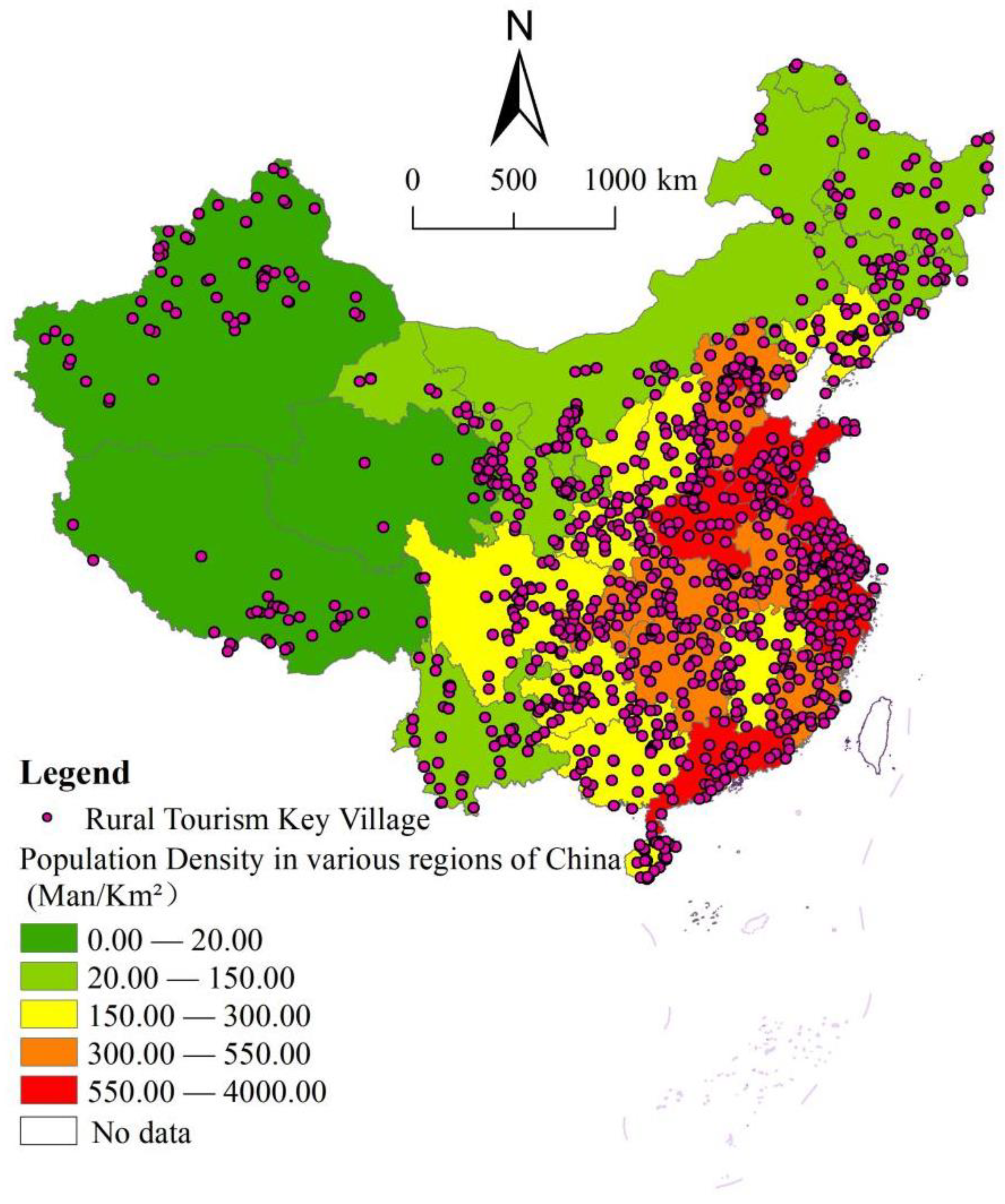

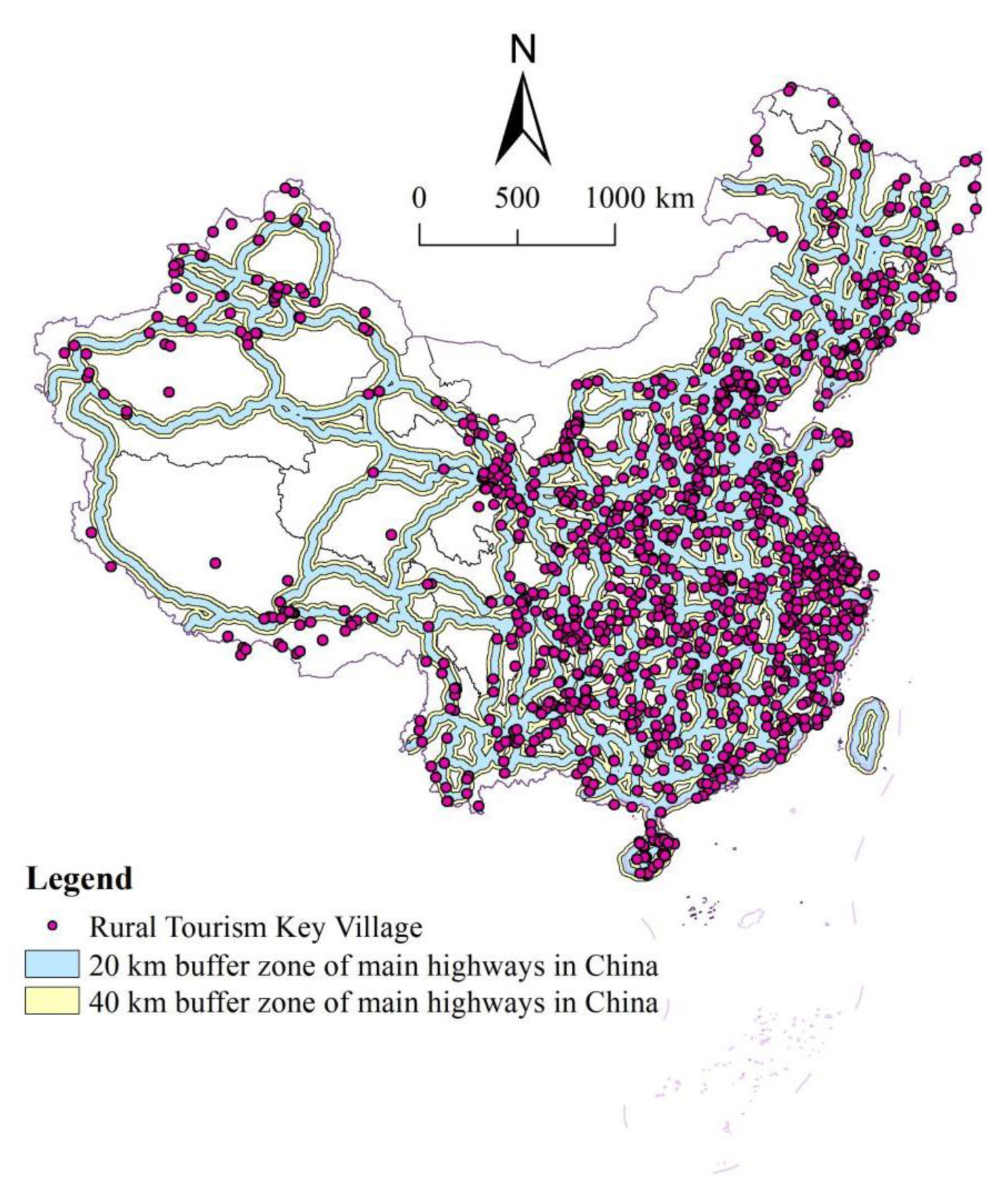
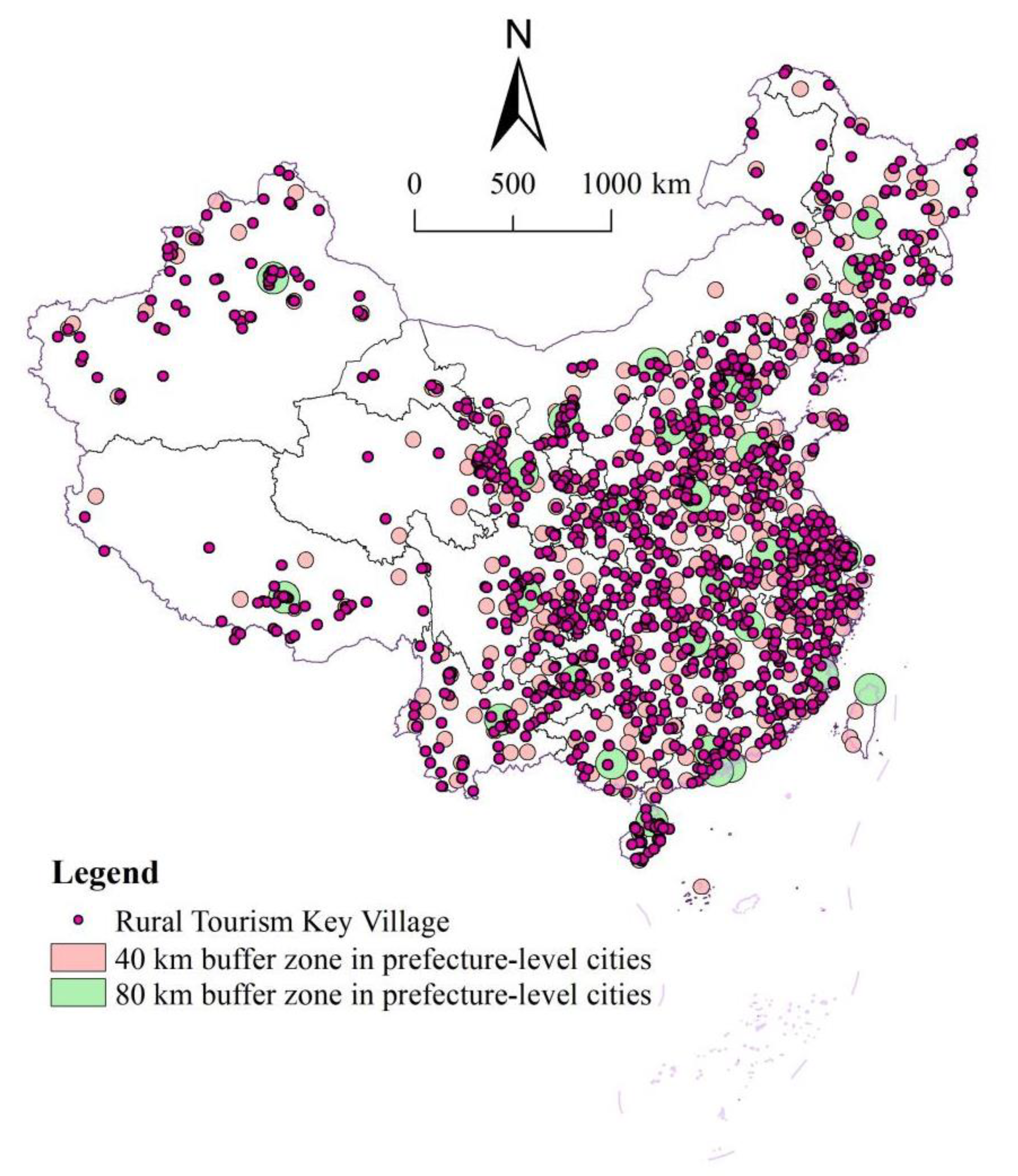
| Area | Eastern China | Central China | Western China | Northeastern China | China |
|---|---|---|---|---|---|
| Number of the first batch | 99 | 64 | 130 | 27 | 320 |
| Proportion of the first batch | 30.94 | 20.00 | 40.62 | 8.44 | 100 |
| Number of the second batch | 209 | 136 | 274 | 61 | 680 |
| Proportion of the second batch | 30.74 | 20.00 | 40.29 | 8.97 | 100 |
| Number of the third batch | 62 | 42 | 78 | 17 | 199 |
| Proportion of the third batch | 31.16 | 21.10 | 39.20 | 8.54 | 100 |
| Number of three batches | 370 | 242 | 482 | 105 | 1199 |
| Proportion of three batches | 30.86 | 20.18 | 40.20 | 8.76 | 100 |
| Area | First Batch | Second Batch | Third Batch | Total Number | Proportion (%) | Cumulative Proportion (%) |
|---|---|---|---|---|---|---|
| Xinjiang | 15 | 41 | 11 | 67 | 5.59 | 5.59 |
| Zhejiang | 14 | 26 | 7 | 47 | 3.92 | 9.51 |
| Jiangsu | 13 | 26 | 7 | 46 | 3.84 | 13.34 |
| Guizhou | 12 | 26 | 7 | 45 | 3.75 | 30.78 |
| Hubei | 11 | 27 | 7 | 45 | 3.75 | 45.04 |
| Jiangxi | 12 | 25 | 7 | 44 | 3.67 | 34.45 |
| Yunnan | 13 | 23 | 7 | 43 | 3.59 | 16.93 |
| Fujian | 11 | 26 | 6 | 43 | 3.59 | 52.04 |
| Sichuang | 12 | 23 | 7 | 42 | 3.50 | 27.02 |
| Hebei | 11 | 24 | 7 | 42 | 3.50 | 37.95 |
| Anhui | 12 | 22 | 7 | 41 | 3.42 | 23.52 |
| Hunan | 11 | 23 | 7 | 41 | 3.42 | 48.46 |
| Shandong | 10 | 24 | 7 | 41 | 3.42 | 61.88 |
| Shaanxi | 11 | 23 | 6 | 40 | 3.34 | 41.28 |
| Guangxi | 11 | 22 | 7 | 40 | 3.34 | 55.38 |
| Guangdong | 10 | 22 | 7 | 39 | 3.25 | 68.31 |
| Gansu | 12 | 20 | 6 | 38 | 3.17 | 20.10 |
| Henan | 10 | 21 | 7 | 38 | 3.17 | 65.05 |
| Beijing | 9 | 23 | 6 | 38 | 3.17 | 73.98 |
| Heilongjiang | 10 | 21 | 6 | 37 | 3.09 | 58.47 |
| Xizang | 9 | 21 | 5 | 35 | 2.92 | 79.73 |
| Chongqing | 9 | 20 | 6 | 35 | 2.92 | 82.65 |
| Liaoning | 9 | 21 | 5 | 35 | 2.92 | 85.57 |
| Ningxia | 9 | 20 | 5 | 34 | 2.84 | 76.81 |
| Jilin | 8 | 19 | 6 | 33 | 2.75 | 88.32 |
| Shanxi | 8 | 18 | 7 | 33 | 2.75 | 91.08 |
| Qinghai | 8 | 20 | 5 | 33 | 2.75 | 93.83 |
| Inner Mongolia | 9 | 15 | 6 | 30 | 2.50 | 70.81 |
| Hainan | 8 | 16 | 5 | 29 | 2.42 | 96.25 |
| Tianjin | 7 | 11 | 5 | 23 | 1.92 | 98.17 |
| Shanghai | 6 | 11 | 5 | 22 | 1.83 | 100.00 |
| Total | 320 | 680 | 199 | 1199 | 100.00 | 100.00 |
| Area | Number | Nearest Neighbor Index | Z Value |
|---|---|---|---|
| China | 1199 | 0.72 | −18.37 ** |
| Eastern China | 370 | 0.29 | −26.17 ** |
| Central China | 242 | 0.35 | −19.41 ** |
| Western China | 482 | 0.56 | −18.56 ** |
| Northeastern China | 105 | 0.28 | −14.03 ** |
| Batch | Global Moran’s I Index | Expectation Index | Variance | Z Value | p-Value |
|---|---|---|---|---|---|
| First batch | 0.206 | −0.029 | 0.006 | 3.086 | 0.002 |
| Second batch | 0.156 | −0.029 | 0.006 | 2.437 | 0.015 |
| Third batch | 0.212 | −0.029 | 0.006 | 3.203 | 0.001 |
| The merger of three batches | 0.185 | −0.029 | 0.006 | 2.824 | 0.005 |
Publisher’s Note: MDPI stays neutral with regard to jurisdictional claims in published maps and institutional affiliations. |
© 2022 by the authors. Licensee MDPI, Basel, Switzerland. This article is an open access article distributed under the terms and conditions of the Creative Commons Attribution (CC BY) license (https://creativecommons.org/licenses/by/4.0/).
Share and Cite
Zhang, Y.; Li, W.; Li, Z.; Yang, M.; Zhai, F.; Li, Z.; Yao, H.; Li, H. Spatial Distribution Characteristics and Influencing Factors of Key Rural Tourism Villages in China. Sustainability 2022, 14, 14064. https://doi.org/10.3390/su142114064
Zhang Y, Li W, Li Z, Yang M, Zhai F, Li Z, Yao H, Li H. Spatial Distribution Characteristics and Influencing Factors of Key Rural Tourism Villages in China. Sustainability. 2022; 14(21):14064. https://doi.org/10.3390/su142114064
Chicago/Turabian StyleZhang, Yunxing, Weizhen Li, Ziyang Li, Meiyu Yang, Feifei Zhai, Zhigang Li, Heng Yao, and Haidong Li. 2022. "Spatial Distribution Characteristics and Influencing Factors of Key Rural Tourism Villages in China" Sustainability 14, no. 21: 14064. https://doi.org/10.3390/su142114064
APA StyleZhang, Y., Li, W., Li, Z., Yang, M., Zhai, F., Li, Z., Yao, H., & Li, H. (2022). Spatial Distribution Characteristics and Influencing Factors of Key Rural Tourism Villages in China. Sustainability, 14(21), 14064. https://doi.org/10.3390/su142114064






